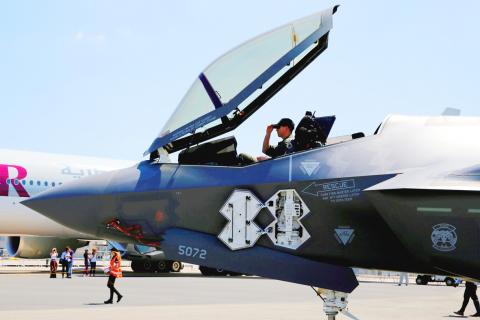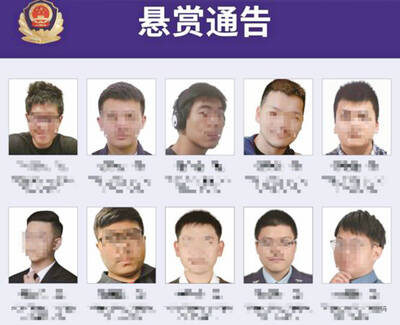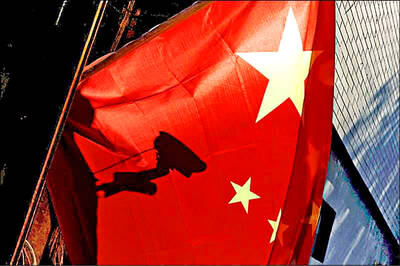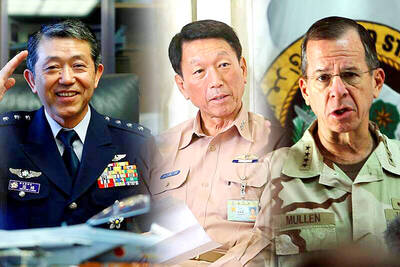US defense contractor Lockheed Martin plans to offer Japan a stealth fighter design based on its export-banned F-22 Raptor and advanced F-35 Lightning II aircraft, two sources said.
Lockheed has discussed the idea with Japanese Ministry of Defense officials and would make a formal proposal in response to a Japanese request for information after it receives permission from the US government to offer the sensitive military technology, said the sources, who have direct knowledge of the proposal.
The decision on whether to release parts of the highly classified aircraft designs and software to help Japan stay ahead of Chinese advances would test US President Donald Trump’s promise to overhaul Washington’s arms export policy.

Photo: Reuters
The proposed aircraft “would combine the F-22 and F-35, and could be superior to both of them,” one of the sources said.
Japan, which is already buying the stealthy F-35 to modernize its inventory, also wants to introduce a separate air superiority fighter in the 2030s to deter intrusions into its airspace by Chinese and Russian jets.
The Japan Air Self-Defense Force operates the Mitsubishi Heavy Industries F-15J, based on the Boeing F-15, and the Mitsubishi F-2, based on the Lockheed Martin F-16. Both designs are decades old.
Japan’s ambition to build its own stealth fighter was in part spurred by Washington’s refusal a decade ago to sell it the twin-engine F-22, which is still considered the world’s best air superiority fighter.
Although the Japanese stealth aircraft program, dubbed the F-3, was conceived as a domestic effort estimated to cost about US$40 billion, Tokyo has recently sought international collaboration in a bid to share the expense and gain access to technology it would otherwise have to develop from scratch.
However, any aircraft built with international partners must have Japanese-designed engines and radar and feature other components made locally, the other source said.
Mitsubishi tested a prototype stealth jet in 2016 that cost the Japanese government US$350 million to develop.
“We are considering domestic development, joint development and the possibility of improving existing aircraft performance, but we have not yet come to any decision,” a ministry spokesman said yesterday.
The Japanese government last month issued a third request for information for the F-3 to foreign defense companies and sent a separate document outlining its requirements in more detail to the British and US governments.
In addition to a proposal from Lockheed Martin, Japan is hoping for responses from Boeing Co, which makes the F/A-18E/F Super Hornet multi-role fighter, and BAE Systems, which is part of the consortium that built the Eurofighter Typhoon high-altitude interceptor.
“We look forward to exploring options for Japan’s F-2 replacement fighter in cooperation with both the Japanese and US governments,” a Lockheed Martin spokeswoman said. “Our leadership and experience in fifth-generation aircraft can be leveraged to cost-effectively provide capabilities to meet Japan’s future security needs.”
Boeing and BAE did not immediately reply to requests for comment.

Taiwan yesterday denied Chinese allegations that its military was behind a cyberattack on a technology company in Guangzhou, after city authorities issued warrants for 20 suspects. The Guangzhou Municipal Public Security Bureau earlier yesterday issued warrants for 20 people it identified as members of the Information, Communications and Electronic Force Command (ICEFCOM). The bureau alleged they were behind a May 20 cyberattack targeting the backend system of a self-service facility at the company. “ICEFCOM, under Taiwan’s ruling Democratic Progressive Party, directed the illegal attack,” the warrant says. The bureau placed a bounty of 10,000 yuan (US$1,392) on each of the 20 people named in

The High Court yesterday found a New Taipei City woman guilty of charges related to helping Beijing secure surrender agreements from military service members. Lee Huei-hsin (李慧馨) was sentenced to six years and eight months in prison for breaching the National Security Act (國家安全法), making illegal compacts with government employees and bribery, the court said. The verdict is final. Lee, the manager of a temple in the city’s Lujhou District (蘆洲), was accused of arranging for eight service members to make surrender pledges to the Chinese People’s Liberation Army in exchange for money, the court said. The pledges, which required them to provide identification

Nine retired generals from Taiwan, Japan and the US have been invited to participate in a tabletop exercise hosted by the Taipei School of Economics and Political Science Foundation tomorrow and Wednesday that simulates a potential Chinese invasion of Taiwan in 2030, the foundation said yesterday. The five retired Taiwanese generals would include retired admiral Lee Hsi-min (李喜明), joined by retired US Navy admiral Michael Mullen and former chief of staff of the Japan Self-Defense Forces general Shigeru Iwasaki, it said. The simulation aims to offer strategic insights into regional security and peace in the Taiwan Strait, it added. Foundation chair Huang Huang-hsiung

’DISTORTION’: Beijing’s assertion that the US agreed with its position on Taiwan is a recurring tactic it uses to falsely reinforce its sovereignty claims, MOFA said The Ministry of Foreign Affairs (MOFA) yesterday said Chinese state media deliberately distorted Taiwan’s sovereign status, following reports that US President Donald Trump agreed to uphold the “one China” policy in a phone call with Chinese President Xi Jinping (習近平). During the more than one-hour-long call, Xi urged Trump to retreat from trade measures that roiled the global economy and cautioned him against threatening steps on Taiwan, a Chinese government summary of the call said. China’s official Xinhua news agency quoted Xi as saying that the US should handle the Taiwan issue cautiously and avoid the two countries being drawn into dangerous